Topeka, Kansas Blood Testing Facilities
 Represents a LabCorp blood testing facility
Represents a LabCorp blood testing facility Represents a Quest Diagnostics blood testing facility
Represents a Quest Diagnostics blood testing facility
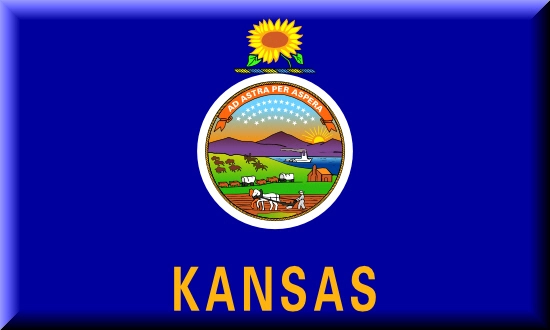
Nearby Labcorp Blood Testing facilities:
- Labcorp Center Distance: 44 m, 6815 Hilltop Rd, Shawnee, Johnson County, KS, 66226
- Labcorp Center Distance: 48 m, 8101 Parallel Pkwy Ste 400, Kansas City, Wyandotte County, KS, 66112
- Labcorp Center Distance: 50 m, 1133 College Ave Bldg E, Manhattan, Riley County, KS, 66502
- Labcorp Center Distance: 51 m, 5701 State Avenue, Kansas City, Wyandotte County, KS, 66102
- Labcorp Center Distance: 52 m, 8901 W 74Th St Ste 147, Shawnee Mission, Johnson County, KS, 66204
- Labcorp Center Distance: 54 m, 7800 W 110Th St, Overland Park, Johnson County, KS, 66210
- Labcorp Center Distance: 57 m, 1000 Carondelet Dr, Kansas City, Jackson County, MO, 64114
- Labcorp Center Distance: 58 m, 6675 Holmes Ste 460, Kansas City, Jackson County, MO, 64131
- Labcorp Center Distance: 59 m, 2340 E Meyer Blvd Ste 328, Kansas City, Jackson County, MO, 64132
- Labcorp Center Distance: 60 m, 9411 N Oak Trafficway Ste 210, Kansas City, Clay County, MO, 64155
- Labcorp Center Distance: 67 m, 212 S Woodbine Rd, Saint Joseph, Buchanan County, MO, 64506
- Labcorp Center Distance: 69 m, 1643 Ne Douglas St, Lees Summit, Jackson County, MO, 64063
- Labcorp Center Distance: 71 m, 19550 E 39Th St Suite 322, Independence, Jackson County, MO, 64057
Nearby Quest Blood Testing facilities:
- Quest Center Distance: 2 m, 1111 Sw Gage Blvd, Topeka, Shawnee County, KS, 66604-2284
- Quest Center Distance: 23 m, 1130 W 4Th St, Lawrence, Douglas County, KS, 66044-1328
- Quest Center Distance: 45 m, 10940 Parallel Pkwy, Kansas City, Wyandotte County, KS, 66109-4512
- Quest Center Distance: 47 m, 20920 W 151St St, Olathe, Johnson County, KS, 66061-7248
- Quest Center Distance: 50 m, 1419 Westport Landing Pl, Manhattan, Riley County, KS, 66502-2908
- Quest Center Distance: 51 m, 10550 Quivira Rd, Overland Park, Johnson County, KS, 66215-2306
- Quest Center Distance: 52 m, 8901 W 74Th St, Shawnee Mission, Johnson County, KS, 66204-2200
- Quest Center Distance: 55 m, 12140 Nall Ave, Overland Park, Johnson County, KS, 66209-2503
- Quest Center Distance: 57 m, 1010 Carondelet Dr, Kansas City, Jackson County, MO, 64114-4823
- Quest Center Distance: 59 m, 1628 E 63Rd St, Kansas City, Jackson County, MO, 64110-3502
- Quest Center Distance: 60 m, 2700 Clay Edwards Dr, North Kansas City, Clay County, MO, 64116-3270
- Quest Center Distance: 65 m, 8421 Clint Dr, Belton, Cass County, MO, 64012-5330
- Quest Center Distance: 66 m, 9151 Ne 81St Ter, Kansas City, Clay County, MO, 64158-1176
- Quest Center Distance: 68 m, 1213 N Belt Hwy, Saint Joseph, Buchanan County, MO, 64506-2546
- Quest Center Distance: 70 m, 19550 E 39Th St S, Independence, Jackson County, MO, 64057-2306
- Quest Center Distance: 75 m, 711 Nw State Route 7, Blue Springs, Jackson County, MO, 64014-2426
Kansas Hormone Replacement Services
Are you interested in Hormone Restoration, but are unsure where you should turn for the best possible treatment? The Conscious Evolution Institute is a licensed medical clinic specializing in Hormone Replacement Therapy options such as Testosterone and Human Growth Hormone HRT. If you are over the age of thirty, and feel that you may be suffering from medical conditions related to premature aging or hormone imbalance, we can help you discover if Hormone Imbalance is wreaking havoc on your life.
The Conscious Evolution Institute has affiliate physicians all over the state of Kansas, and all you have to do is contact us to set up an appointment. We have streamlined the entire process, and can even have our affiliate meet you at your home or business. If you are curious about Hormone Replacement, don't wait. Call us today!
Kansas Human Growth Hormone Therapy
Aging is caused by many factors. Some of these factors are environmental, others are genetic, but did you know that Hormone Imbalance can exacerbate conditions related to aging, and can even encourage the onset of premature aging? HGH Deficiency can be a major stumbling block in your attempt to preserve optimal health. Symptoms of Growth Hormone Deficiency include lethargy, increased susceptibility to illness, osteoporosis, significantly decreased metabolism, cognitive and memory decline, and reduced muscle mass.
HGH Injection Therapy can alleviate the symptoms of premature aging in patients with HGH Deficiency, and can even reverse many of the symptoms. Injections are delivered subcutaneously, and the shots are nearly painless and easy to incorporate into your routine.
We also offer an alternative form of therapy known as Sermorelin HGH Restoration, which increases the body's endogenous Growth Hormone Secretion by supplementing an important precursor hormone called GH-RH. Both methods are highly effective, and have subtle benefits and drawbacks. The HGH Specialists at our clinic would be happy to discuss the details.
Kansas Testosterone Replacement Therapy
Although we are most vocal about our HGH Therapy Services, we also offer a number of other forms of Hormone Replacement, including Testosterone HRT. Most men these days are aware of Erectile Dysfunction, and somewhat aware of Low-T. Television and radio advertisements emphasize the sexual benefits of Low-T Treatments, but Testosterone Deficiency is a complex disorder which impacts a number of aspects of male health.
Symptoms of Age-Related Low-T include, loss of strength, diminished libido, inhibited sexual function, increased weight gain, trouble sleeping, loss of assertiveness, and increased anxiety, just to name some of the symptoms. The Conscious Evolution Institute offers a number of methods to restore your Testosterone Levels, including Testosterone Gels, Testosterone Injections, and Testosterone Patches.
Kansas HCG Weight Loss Diet
If you are particularly conscious about your weight, and are obese or overweight, HCG Injection Therapy may be the ideal solution to your weight loss woes. HCG gets to the root cause of why most diets fail: Hunger.
Bio-Identical HCG Shots have the capability to actually limit the impact of hunger on the brain, making it easier to stay on a restrictive diet. HCG stimulates adipose fat metabolism, and can encourage you to lose as much as a pound per day without having a negative impact on your day-to-day life.
Major Cities in Kansas
Wichita
Wichita is the most populous city in the state of Kansas, and is located in the south-central portion of the state. Wichita is commonly referred to as the Air Capital of the World, because of its national and international importance as an aircraft manufacturing center. A number of these manufacturers operate out of Wichita, including Spirit Aerosystems, Learjet, and Boeing.
Wichita is also home to Wichita State University, home to the Shockers. Wichita is also recognized as a historical center for entrepreneurial activity, the original home of a number of different successful companies, including White Castle, Pizza Hut, and Coleman.
Overland Park
Overland Park is the second largest city in Kansas by population, and is the biggest suburb of Kansas City. Overland Park has a large business presence, and is home to a large number of business headquarters, including Sprint, Compass Minerals, Ferrellgas, and YRC Worldwide. Sprint is the biggest employer in the city.
Overland Park is considered one of the top places to raise a family in the country, due to its low cost of living and significant employment opportunities. There are a number of tourists destinations in Overland Park, including the Deanna Rose Children's Homestead, and the Overland Park Arboretum and Botanical Garden.
Kansas City
Kansas City, Kansas is the 3rd most populous city in Kansas. Although metro Kansas City is significantly larger than Wichita, more people live in Kansas City, Missouri than Kansas City, Kansas. Kansas City, Kansas has a strong manufacturing and transportation presence, and two of its largest private employers are General Motors and BNSF Railway. Kansas City, Kansas has one professional sports team, the MLS Sporting Kansas City.
Olathe
Olathe is the second largest suburb of Kansas City, Kansas and is located immediately southwest of Overland Park. The city is also the fourth largest city in the state of Kansas. Olathe is a major midwestern industrial city, with a number of companies based in the city limits, including Garmin, ALDI, Honeywell, and Grundfos. Farmers Insurance is also a major employer in the area. Although the company is based in L.A., Farmers has more workers in Olathe than anywhere else in the nation.
Topeka
Topeka is the fifth largest city in Kansas, as well as the capital of the state. An interesting fact about Topeka is no one knows what Topeka actually means. It was named after the Indian name of the Kansas River. The largest employer in Topeka is the state government. Twenty percent of the workers in the city are government employees. Education is the second largest employer, followed by healthcare. Historically, Topeka is known for Brown vs. Board of Education, the landmark ruling which desegregated schools across the country.
All About Topeka, Kansas Geographic Area
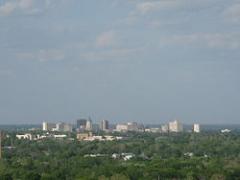

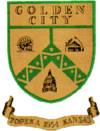
Topeka (/tɵËnpiËakÉo/; Kansa: TR³ Pee Kuh) is the capital city of the U.S. state of Kansas and the county seat of Shawnee County. It is situated along the Kansas River in the central part of Shawnee County, located in northeast Kansas, in the Central United States. As of the 2010 census, the city population was 127,473. The Topeka Metropolitan Statistical Area, which includes Shawnee, Jackson, Jefferson, Osage, and Wabaunsee counties, had an population of 233,870 in 2010 census. The city is well known for the landmark United States Supreme Court case Brown v. Board of Education of Topeka, which overturned Plessy vs. Ferguson and declared segregation in public schools on account of race to be unconstitutional. Three ships of the US Navy have been named USS Topeka in honor of the city.
Topeka means "to dig good potatoes" in the languages of the Kansa and the Ioway. The potato referred to is the prairie potato (Psoralea esculenta), a perennial herb which is an important food for many Native Americans. As a placename, Topeka was first recorded in 1826 as the Kansa name for what is now called the Kansas River. Topeka's founders chose the name in 1855 because it "was novel, of Indian origin and euphonious of sound." The mixed-blood Kansa Indian, Joseph James, called Jojim, is credited with suggesting the name of Topeka. The city, laid out in 1854, was one of the Free-State towns founded by Eastern antislavery men immediately after the passage of the Kansas-Nebraska Bill. In 1857, Topeka was chartered as a city.
In the 1840s, wagon trains made their way west from Independence, Missouri, on a journey of 2,000 miles (3,000 km), following what would come to be known as the Oregon Trail. About 60 miles (97 km) west of Kansas City, Missouri, three half Kansas Indian sisters married to the French-Canadian Pappan brothers established a ferry service allowing travelers to cross the Kansas River at what is now Topeka. During the 1840s and into the 1850s, travelers could reliably find a way across the river, but little else was in the area.
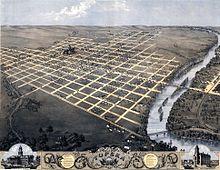
In the early 1850s, traffic along the Oregon Trail was supplemented by trade on a new military road stretching from Fort Leavenworth through Topeka to the newly-established Fort Riley. In 1854, after completion of the first cabin, nine men established the Topeka Town Association. Included among them was Cyrus K. Holliday, an "idea man" who would become mayor of Topeka and founder of the Atchison, Topeka & Santa Fe Railroad. Soon, steamboats were regularly docking at the Topeka landing, depositing meat, lumber, and flour and returning eastward with potatoes, corn, and wheat. By the late 1860s, Topeka had become a commercial hub providing many Victorian era comforts.
After a decade of abolitionist and pro-slavery conflict that gave the territory the nickname Bleeding Kansas, Kansas was admitted to the Union in 1861 as the 34th state. Topeka was finally chosen as the capital, with Dr. Charles Robinson as the first governor. In 1862, Cyrus K. Holliday donated a tract of land to the state for the construction of a state capitol. Construction of the Kansas State Capitol began in 1866. It would take 37 years to build the capitol, first the east wing, and then the west wing, and finally the central building, using Kansas limestone. In fall 1864 a stockade fort, later named Fort Simple, was built in the intersection of 6th and Kansas Avenues to protect Topeka, should Confederate forces then in Missouri decide to attack the city. It was abandoned by April 1865 and demolished in April 1867.
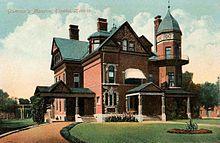
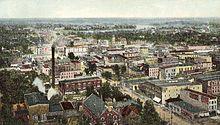
State officers first used the state capitol in 1869, moving from Constitution Hall, what is now 427-429 S. Kansas Avenue. Besides being used as the Kansas statehouse from 1863 to 1869, Constitution Hall is the site where anti-slavery settlers convened in 1855 to write the first of four state constitutions, making it the "Free State Capitol." The National Park Service recognizes Constitution Hall - Topeka as headquarters in the operation of the Lane Trail to Freedom on the Underground Railroad, the chief slave escape passage and free trade road.
Although the drought of 1860 and the ensuing period of the Civil War slowed the growth of Topeka and the state, Topeka kept pace with the revival and period of growth that Kansas enjoyed from the close of the war in 1865 until 1870. In the 1870s, many former slaves known as Exodusters, settled on the east side of Lincoln Street between Munson and Twelfth Streets. The area was known as Tennessee Town because so many of them were from that state. The first African American Kindergarten west of the Mississippi was organized in Tennessee Town by Dr. Charles Sheldon, pastor of the Central Congregational Church in 1893.
Lincoln College, now Washburn University, was established in 1865 in Topeka by a charter issued by the State of Kansas and the General Association of Congregational Ministers and Churches of Kansas. In 1869, the railway started moving westward from Topeka, where general offices and machine shops of the Atchison, Topeka & Santa Fe Railroad system were established in 1878.
During the late 1880s, Topeka passed through a boom period that ended in disaster. There was vast speculation on town lots. The 1889 bubble burst and many investors were ruined. Topeka, however, doubled in population during the period and was able to weather the depressions of the 1890s.
Early in the 20th Century, another kind of boom, this time the automobile industry, took off, and numerous pioneering companies appeared and disappeared. Topeka was not left out. The Smith Automobile Company was founded there in 1902, lasting until 1912.
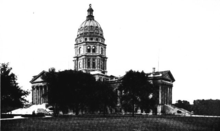
Home to the first African-American kindergarten west of the Mississippi River, Topeka became the home of Linda Brown, the named plaintiff in Brown v. Board of Education which was the case responsible for eliminating the standard of "separate but equal", and requiring racial integration in American public schools. In 1960, the Census Bureau reported Topeka's population as 91.8% white and 7.7% black.
At the time the suit was filed, only the elementary schools were segregated in Topeka, and that Topeka High School had been fully integrated since its inception in 1871. Furthermore, Topeka High School was the only public high school in inner-city Topeka. Other rural high schools existed at that time, such as Washburn Rural High School aecreated in 1918 aeand Seaman High School aecreated in 1920. Highland Park High School became part of the Topeka school system in 1959 along with the opening of Topeka West High School in 1961. A Catholic high school aeAssumption High School, later renamed Capitol Catholic High School, then in 1939 again renamed, to Hayden High School after its founder, Father Francis Hayden ae also served the city beginning in 1911.
Monroe Elementary, a segregated school that figured in the historic Brown v. Board of Education decision, is now Brown v. Board of Education National Historic Site with interpretive exhibits. The National Historic Site was opened by President George W. Bush on May 17, 2004.
Topeka has struggled with the burden of racial discrimination even after Brown. New lawsuits attempted unsuccessfully to force suburban school districts that ring the city to participate in racial integration with the inner city district. In the late 1980s a group of citizens calling themselves the Task Force to Overcome Racism in Topeka formed to address the problem in a more organized way.
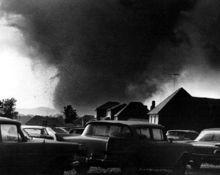
On June 8, 1966, Topeka was struck by an F5 rated tornado, according to the Fujita scale. It started on the southwest side of town, moving northeast, passing over a local landmark named Burnett's Mound. According to a local Indian legend, this mound was thought to protect the city from tornadoes if left undisturbed. A few years prior to the tornado strike saw development near the mound including a water tank constructed near the top of the mound against the warnings of local Native Americans. The tornado went on to rip through the city, hitting the downtown area and Washburn University. Total dollar cost was put at $100 million making it, at the time, one of the most costly tornadoes in American history. Even to this day, with inflation factored in, the Topeka tornado stands as one of the most costly on record. It also helped bring to prominence future CBS and A&E broadcaster Bill Kurtis, who became well known for his televised admonition to "take cover, for God's sake, take cover" on WIBW-TV during the tornado. (The city is home of a National Weather Service Forecast Office that serves 23 counties in north-central, northeast, and east-central Kansas).
Topeka recovered from the 1966 tornado and has sustained steady economic growth. Washburn University, which lost several historic buildings from the tornado, received financial support from the community and alumni to rebuild many school facilities. Today, university facilities offer more than one million square feet of modern academic and support space.
In 1974, Forbes Air Force Base closed and more than 10,000 people left Topeka, influencing the city's growth patterns for years to come. During the 1980s, Topeka citizens voted to build a new airport and convention center and to change the form of city government. West Ridge Mall opened in 1988 and in 1989 Topeka became a motorsports mecca with the opening of Heartland Park Topeka. The Topeka Performing Arts Center opened in 1991. In the early 1990s the city experienced business growth with Reser's Fine Foods locating in Topeka and expansions for Santa Fe and Hill's Pet Nutrition.
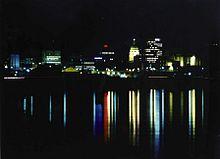
During the 1990s voters approved bond issues for public school improvements including magnet schools, technology, air conditioning, classrooms, and a sports complex. Voters also approved a quarter-cent sales tax for a new Law Enforcement Center, and in 1996 approved an extension of the sales tax for the East Topeka Interchange connecting the Oakland Expressway, K-4, I-70, and the Kansas Turnpike. During the 1990s Shawnee county voters approved tax measures to expand the Topeka and Shawnee County Public Library. The Kansas Legislature and Governor also approved legislation to replace the majority of the property tax supporting Washburn University with a countywide sales tax.
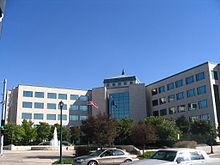
In 2000 the citizens again voted to extend the quarter-cent sales tax, this time for the economic development of Topeka and Shawnee County. In August, 2004, Shawnee County citizens voted to repeal the 2000 quarter-cent sales tax and replace it with a 12- year half-cent sales tax designated for economic development, roads, and bridges. Each year the sales tax funds provide $5 million designated for business development job creation incentives, and $9 million for roads and bridges. Planning is under way to continue to redevelop areas along the Kansas River, which runs west to east through Topeka. In the Kansas River Corridor through the center of town, Downtown Topeka has experienced apartment and condominium loft development, and facade and streetscape improvements. On the other side of the river, Historic North Topeka has benefited from a major streetscape project and the renovated Great Overland Station, regarded as the finest representation of classic railroad architecture in Kansas. The Great Overland Station is directly across the river from the State Capitol, which is undergoing an eight-year, $283 million renovation.
On March 1, 2010, Topeka Mayor Bill Bunten issued a proclamation calling for Topeka to be known for the month of March as "Google, Kansas, the capital city of fiber optics." The name change came from Ryan Gigous, who wanted to "re-brand" the city with a simple gesture. This was to help "support continuing efforts to bring Google's fiber experiment" to Topeka, though it was not a legal name change. Lawyers advised the city council and mayor against an official name change. Google jokingly announced that it would change its name to Topeka to "honor that moving gesture" on April 1, 2010 (April Fools Day) and changed its home page to say Topeka. In its official blog, Google announced that this change thus affected all of its services as well as its culture, e.g. "Googlers" to "Topekans", "Project Virgil" to "Project Virpeka", and proper usage of "Topeka" as an adjective and not a verb, to avoid the trademark becoming genericized.
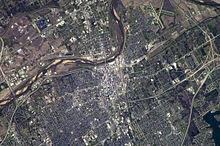
Topeka is located at 39 °03 a²N 95 °41 a²W / 39.05 °N 95.683 °W / 39.05; -95.683. Topeka is in north east Kansas at the intersection of I-70 and U.S. Highway 75. It is the origin of I-335 which is a portion of the Kansas Turnpike running from Topeka to Emporia, Kansas. Topeka is also located on U.S. Highway 24 and U.S. Highway 40. 40 is coincident with I-70 west from Topeka. According to the United States Census Bureau, the city has a total area of 61.47 square miles (159.2 km ²), of which, 60.17 square miles (155.83 km ²) of it is land and 1.3 square miles (3.36 km ²) is water.
In 2007, Forbes Magazine named Topeka as one of the leading U.S. cities in terms of having the biggest variations in temperature, precipitation, and wind. Topeka has a humid continental climate (Koppen climate classification Dfa), with hot, somewhat humid summers and cool to cold, fairly dry winters. Over the course of a year, temperatures range from an average low of about 17 °F ( na8 °C) in January to an average high of nearly 90 °F (32 °C) in July. The maximum temperature reaches 90 °F (32 °C) an average of 45 days per year and reaches 100 °F (38 °C) an average of 4 days per year. The minimum temperature falls below 0 °F ( na18 °C) an average of 4 nights per year, and there are 27 days per year that stay below freezing. Typically the first fall freeze occurs between the last week of September and the end of October, and the last spring freeze occurs between the first week of April and early May.
The area receives nearly 36 inches (91 cm) of precipitation during an average year with the largest share being received in May and June aethe April through June period averages 32 days of measurable precipitation. Generally, the spring and summer months have the most rainfall, with autumn and winter being fairly dry. During a typical year the total amount of precipitation may be anywhere from 25 to 47 inches (63 to 120 cm). Much of the rainfall is delivered by thunderstorms. These can be severe, producing frequent lightning, large hail, and sometimes tornadoes. There are on average 100 days of measurable precipitation per year. Winter snowfall is light, as is the case in most of the state, not because of lack of sufficiently cold temperatures, but as a result of the dry, sunny weather patterns that dominate Kansas winters, which do not allow for sufficient moisture for significant snowfall. Winter snowfall averages almost 20 inches (51 cm), but the median is less than 11 inches (28 cm). Measurable snowfall occurs an average of 15 days per year, with at least an inch of snow being received on seven of those days. Snow depth of at least an inch occurs an average of 26 days per year.
Topeka's population was estimated to be 122,113 in the year 2006, a decrease of 988, or -0.8%, over the previous six years.
As of the census of 2010, there were 127,473 people, 53,943 households, and 30,707 families residing in the city. The population density was 2118.6 people per square mile (818/km ²). There were 59,582 housing units at an average density of 990.3 per square mile (382.3/km ²). The racial makeup of the city was 76.2% White, 11.3% African American, 1.4% Native American, 1.3% Asian, 0.1% Pacific Islander, 4.7% from other races, and 4.9% from two or more races. Hispanic or Latino of any race were 13.4% of the population. Non-Hispanic Whites were 69.7% of the population in 2010, down from 86.3% in 1970.
There were 53,943 households out of which 26.4% had children under the age of 18 living with them, 37.9% were married couples living together, 14.2% had a female householder with no husband present, 4.8% had a male householder with no wife present, and 43.1% were non-families. 35.9% of all households were made up of individuals and 12% had someone living alone who was 65 years of age or older. The average household size was 2.29 and the average family size was 2.99.
The median age in the city was 36 years. 24.4% of residents were under the age of 18; 9.8% were between the ages of 18 and 24; 26.1% were from 25 to 44; 25.4% were from 45 to 64; and 14.3% were 65 years of age or older. The gender makeup of the city was 47.8% male and 52.2% female.
As of 2000 the median income for a household in the city was $35,928, and the median income for a family was $45,803. Males had a median income of $32,373 versus $25,633 for females. The per capita income for the city was $19,555. About 8.5% of families and 12.4% of the population were below the poverty line, including 16.7% of those under age 18 and 8.2% of those age 65 or over.
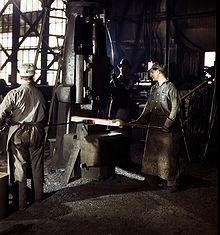
Being the state's capital city, Topeka's largest employer is the State of Kansas aeemploying about 8,400 people, or 69% of the city's government workers. Altogether, government workers make up one out of every five employed persons in the city.
The educational, health and social services industry makes up the largest proportion of the working population (22.4%). The four school districts employ nearly 4,700 people, and Washburn University employs about 1,650. Three of the largest employers are Stormont-Vail HealthCare (with about 3,100 employees), St. Francis Health Center (1,800), and Colmery-O'Neil VA Hospital (900).
The retail trade employs more than a tenth of the working population (11.5%) with Wal-Mart and Dillons having the greater share. Nearly another tenth is employed in manufacturing (9.0%). Top manufacturers include Goodyear Tire and Rubber Company, Payless ShoeSource, Hill's Pet Nutrition, Frito-Lay, and Jostens Printing and Publishing. Jostens announced plans in May 2012 to move production from its Topeka facility to Clarksville, Tennessee, affecting approximately 372 employee positions. Southwest Publishing & Mailing Corporation, a smaller employer, has its headquarters in Topeka.
Other industries are finance, insurance, real estate, and rental and leasing (7.8%); professional, scientific, management, administrative, and waste management services (7.6%); arts, entertainment, recreation, accommodation and food services (7.2%); construction (6.0%); transportation and warehousing, and utilities (5.8%); and wholesale trade (3.2%). Blue Cross and Blue Shield of Kansas is the largest insurance employer, with about 1,800 employees. BNSF Railway is the largest transportation employer, with about 1,100. Westar Energy employs nearly 800. About a tenth of the working population is employed in public administration (9.9%).
Major companies based in Topeka:
Topeka is sometimes cited as the home of Pentecostalism as it was the site of Charles Fox Parham's Bethel Bible College, where glossolalia was first claimed as the evidence of a spiritual experience referred to as the baptism of the Holy Spirit in 1901. It is also the home of Reverend Charles Sheldon, author of In His Steps, and was the site where the famous question "What would Jesus do?" originated in a sermon of Sheldon's at Central Congregational Church. The First Presbyterian Church in Topeka is one of the very few churches in the U.S. to have its sanctuary completely decorated with Tiffany stained glass (another is St. Luke's United Methodist in Dubuque, Iowa). The highly controversial Westboro Baptist Church is located in Topeka. There is a large Roman Catholic population, and the city is home to nine Roman Catholic parishes, five of which feature elementary schools. Grace Cathedral of the Episcopal Diocese of Kansas is a large Gothic Revival structure located in the city. Topeka also has a claim in the history of the Baha'i Faith in Kansas. Not only does the city have the oldest continuous Baha'i community in Kansas (beginning in 1906), but that community has roots to the first Baha'i community in Kansas, in Enterprise, Kansas in 1897. This was the second Baha'i community in the western hemisphere.
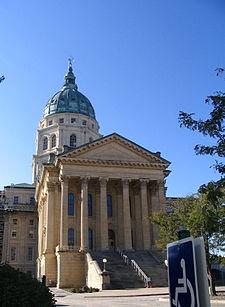
Topeka is the home of a daily newspaper, the Topeka Capital-Journal, and a bi-weekly newspaper, The Topeka Metro News.
The following radio stations are licensed to Topeka:
AM
FM
Additionally, most of the Kansas City stations provide at least grade B coverage of Topeka. KANU-FM in Lawrence (in the Kansas City market) serves as Topeka's NPR member station as well.
The following television stations are licensed to Topeka:
Most Kansas City stations are available on cable, which has been the case for many years.
The chief executives of Topeka are Mayor Bill Bunten (R) and interim City Manager Dan Stanley.
Although Topeka experienced problems with crime in the 1990s, the city's crime rates have improved in the past decade. The city is now breaking trends when it comes to violent crime, so much so that it has gained the interest of researchers from Michigan State University. Since 2000, most cities with a population greater than 100,000 have seen an increase in violent crimes. Topeka's crime rates are decreasing. Researchers credit good communication between law enforcement agencies, informed media outlets, and strong community involvement for Topeka's success. Topeka was one of four cities, along with Chicago, Tampa, and El Monte, California, to be studied.
Overall, crime in Topeka was down nearly 18 percent in the first half of 2008, compared with the same period of 2007. Topeka police reported a 6.4 percent drop in crime from 2007 to 2008, including significant reductions in business robberies and aggravated assaults and batteries, as well as thefts.
On October 11, 2011, the Topeka city council agreed to repeal the ordinance banning domestic violence in an effort to force the Shawnee County District Attorney to prosecute the cases. Shawnee County District Attorney Chad Taylor said that the DA "would no longer prosecute misdemeanors committed in Topeka, including domestic battery, because his office could no longer do so after county commissioners cut his budget by 10 percent." The next day, Taylor said that his office would "commence the review and filing of misdemeanors decriminalized by the City of Topeka." The same day it was announced that 17% of the employees in the District Attorney's office would be laid off.
Topeka is served by four public school districts including:
Topeka is also home to several private and parochial schools such as Topeka Collegiate and Cair Paravel-Latin School. There are also elementary and junior high schools supported by other Christian denominations. Hayden High School, a Catholic High School is also located in Topeka.
Topeka has several colleges, universities and technical schools including Washburn University, Friends University, Washburn Institute of Technology (Formerly Kaw Area Technical School), and the Baker University School of Nursing. The now defunct College of the Sisters of Bethany and Bethel Bible College both once called Topeka their home.
Topeka has two major hospitals, Stormont-Vail and St. Francis Hospital both located in central Topeka. Topeka is also home to the Colmery-O'Neil VA Medical Clinic.
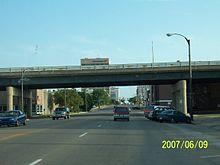
I-70, I-470, and I-335 all go through the City of Topeka. I-335 is part of the Kansas Turnpike where it passes through Topeka. Other major highways include: US-24, US-40, US-75, and K-4. Major roads within the city include NW/SW Topeka Blvd. SW Wanamaker Road. N/S Kansas Ave. SW/SE 29th St. SE/SW 21st St. SE California Ave. SW Gage Blvd. and SW Fairlawn Rd.
Philip Billard Municipal Airport (TOP) is located in the Oakland area of Topeka and Forbes Field (FOE) is located in south Topeka in Pauline, Kansas. Passenger air service is not currently available. Service may be added in the near future. Forbes Field also serves as an Air National Guard base, home of the highly decorated 190th Air Refueling Wing. MHK located in Manhattan, Kansas is the closest commercial airport, MCI in Kansas City is the closest major airport.
Passenger rail service provided by Amtrak stops at the Topeka Station. Current service is via the Chicago-to-Los Angeles Southwest Chief during the early morning hours. However, the Kansas Department of Transportation recently asked Amtrak to study additional service options, including daytime service to Oklahoma City. Freight service is provided by the Burlington Northern Santa Fe railroad and Union Pacific Railroad.
Bus service is provided by Greyhound Lines.
Local transit service is provided by the Topeka Metropolitan Transit Authority. The agency offers bus service from 6 am to 6:30 pm Monday through Friday, and 7 am to 5 pm on Saturday. The agency also provides demand response general public taxi service which operates evenings from 8 pm until 11:30 pm and on Sundays.
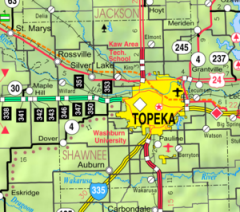
Word Count: 4924





